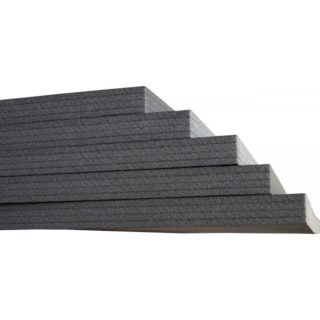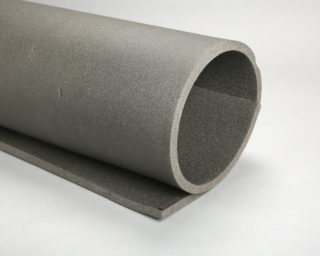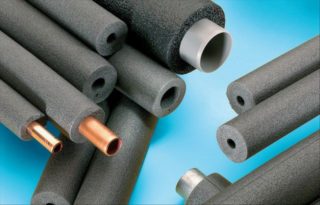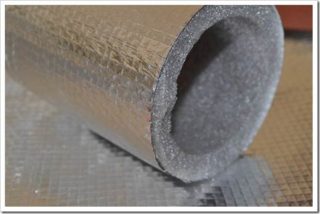Pipes that are made for communication lines are made of heat-conducting materials: steel, fiberglass, polymers. Due to this, they freeze quite quickly and require mandatory warming. Thanks to the insulation for pipes made of foamed polyethylene (PES, polyethylene foam), engineering networks will not be exposed to cold. The use of insulation on heating mains will prevent large heat losses.
Types and sizes
The heat insulator is created by foaming a synthetic polymer of ethylene, which is synthesized from petroleum products. The result is an elastic polyethylene material with a porous structure.
Thermal insulation material is made of two types:
- Unstitched. A polymer with no molecules in the space of additional bonds, due to which the material is less flexible, strong and dense.
- Stitched. The material is made by chemical or radiation method, which creates linear and transverse molecular bonds. The insulator is dense, durable and elastic; after being squeezed, it quickly restores its original shape.
As a rule, the length of the pipe segments is two meters, the thickness and diameter are different. The thickness indicator is 6, 9, 13, 20 or 32 mm, the internal section is from 6 to 200 mm.
For thermal insulation of communication lines that are directly exposed to ultraviolet radiation, PES with a colored surface is used, which reliably protects the thermal insulation material. There is also polyethylene with a foil coating that protects the pipes from low and high temperatures. Another variety is a roll type heat insulator with special tape. The material is used to insulate communication networks in places with difficult access.
The most well-known PES manufacturers are Energoflex, Thermoflex and Termocom. The first organization produces heat insulators, which include waterproofing in their composition. The other two are more concerned with ensuring the safety of the pipes.
Specifications
Polyethylene foam is classified as foam. The main technical characteristics of the insulator include:
- heat conductivity - from 0.034 to 0.04 W / mK;
- density - 25-200 kg / m³;
- susceptibility to moisture - 0.9–1.1 percent;
- vapor permeability value - 1.8 mg / m * h * Pa;
- combustibility group - G1 – G4;
- degree of form stability - high;
- noise absorption - 16 dB;
- application at temperatures from -80 to +95 degrees.
The cross-linked insulation for pipes made of foamed polyethylene with the shape memory effect of the insulated structures has greater strength, elasticity, and density. For this reason, in order for the pipe thermal insulation coating to be high-quality and effective, it is worth choosing it.
For the insulation coating of communication systems, foamed polyethylene in the form of split tubes is most often used, which have a technical slot along the entire length and are easily put on already installed engineering systems. It turns out a kind of coat for heating pipes or water supply. To put such an insulator, there is no need to parse the trunk sections. The halves are butt-joined and glued with metallic tape.
Areas of use
The material is used to ensure reliable thermal insulation coating of utilities. Foamed polyethylene cases are suitable for insulation of pipelines:
- heating;
- hot and cold water supply;
- sewers;
- air conditioning systems;
- ventilation ducts;
- cooling units.
A sheet insulator based on polyethylene foam is used to warm the walls of buildings from the outside and from the inside, basements, foundation foundations, attics. It is used for thermal protection of baths and saunas. Harnesses of this material are used to seal interpanel seams, cracks in window and door openings.
Advantages and disadvantages of PES insulation
The structure of the material is similar to foam and is not resistant to mechanical stress, which is why it can not be used as insulation for walls and floors. Due to the closed fine-meshed porous structure, polyethylene foam does not absorb moisture and does not allow water vapor to pass through, and is resistant to rust. Condensation does not appear on surfaces covered with foamed polyethylene, and there is no need for an additional waterproofing layer during pipe insulation.
The advantages of the material include:
- Significant heat-insulating qualities. Its use reduces heat loss by up to 75 percent and provides liquids with the same temperature during transport.
- Resistance to temperature jumps in the range from -80 to +95 ºС. Due to this indicator, the insulating material is allowed for operation in harsh climatic conditions.
- Soundproofing properties. Foamed polyethylene does not allow sounds from the fluid that circulates in communication systems, partially drowns out the level of structural noise.
- Low weight. Thermal insulation with lightweight pipes made of foamed polyethylene does not create an additional load on the utilities.
- Easy to install - no special equipment needed.
- Quick restoration of the original form after compression.
- Resistance to biological effects. Fungal deposits and mold do not form on foamed polyethylene.
- Immunity to chemical elements. Qualitative indicators of the material do not change upon contact with a variety of mortars, alkaline and acidic environments. Thanks to this, it can be used as insulation for pipes that pass through concrete structures or are buried in the ground.
- Environmental friendliness. Foamed polyethylene does not emit harmful substances. Such a heat insulator is allowed for insulation of pipes in educational institutions, medical centers, as well as technological pipelines in food production.
A distinctive feature of the insulator is its low cost and durability - the operational period can reach 50 years.
With all its advantages, foamed polyethylene is quickly melted when exposed to open flame. Flames from it can spread to nearby objects. Another imperfection is a high susceptibility to the influence of ultraviolet radiation. Foamed polyethylene under the influence of direct sunlight becomes brittle, painted and cracked. To prevent the negative effects of UV rays, the outside of the material is covered with foil.
The insulator is easily damaged by a sharp object, the resulting gap can spread along the entire length of the shell. To avoid damage, immediately glue the gap with reinforcing tape.
Installation Nuances
Polyethylene insulation without problems is installed on a pipeline of any complexity. No special fixtures are required for this. To make installation even easier, cuts are provided on the insulation pipes.However, there are also monolithic insulators, which are easily cut along the length with the help of an ordinary stationery knife with a replaceable blade. The cylinder cut on its own, worn on the pipe, will have to be fixed in one place, fastened with tape for pipes on top.
Installation of a warming shell:
- Before installing a heat insulator, the pipe surface of the pipe is cleaned of mortars and dirt for a snug fit. If the engineering network is made of metal, anti-corrosion cleaning is carried out.
- The incision is glued with a special adhesive composition (“Acrol Contact”, “KVIK-BOND”, “Neoprene 2136”, “88-NP”). Also, with the help of glue, the beginning and end of the case are attached to the pipe section.
- The joint after joining the edges is grabbed with brackets in increments of approximately 20 cm. After the adhesive has dried, the staples are removed, the seam is glued with reinforced tape.
It is necessary to glue the cut along the entire length if the street pipeline is insulated. For engineering structures in the room, you can only fix the edges and close the seam with tape. It is important that the internal section of the case exactly matches the size of the pipeline. If the end edge is self-adhesive, installation is even easier. It is only necessary to remove the protective film and fix the incision.
The low price combined with low heat loss and a long service life make foam polyethylene attractive for use as a heat insulator. The ease of installation allows you to carry out the work yourself, without the involvement of specialists.








